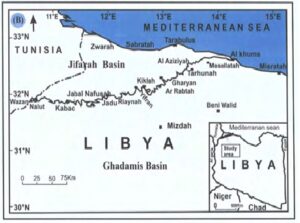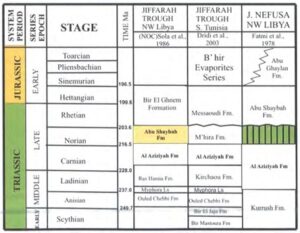Geochemistry and Petrographic Study of Abu Shaybah Formation NW Libya
Mohamed Aljelani Masoud
Geology Department- Faculty of Sciences- Al-zintan University
HNSJ, 2022, 3(12); https://doi.org/10.53796/hnsj31229
Published at 01/12/2022 Accepted at 10/11/2022
Abstract
This paper studies the geochemistry, petrography and diagenesis of sandstone of Abu Shaybah formation in the northwest Libya. The study describes the geology of the formation and the petrographic analysis shows that the Abu Shaybah sandstone are detrital grains of monocrystalline and polycrystalline quartz, the grains were range from poorly to moderately sorted with some subangular grains. The Abu Shaybah sandstone are very pure quartz arenites with little feldspar or rock fragments.
The geochemical analysis shows that all major elements has a minor variation in concentration values and the high concentration of all elements are SiO₂. The chemical alteration index in the studied samples ranges from 63.55% to 72.04 % and that is indicate the weathering in the sandstone source area is low to moderate.
Digenetic analysis shows that there are chemical and physical compaction which can be seen from dissolution of grains and straight grains contact. Late cementation has reduced the pore spaces such as quartz overgrowth, while in some sample the pore space has been increased due to grains alteration.
Key wards: Abu Shaybah, sandstone, petrographic, daignesis, quartz.
Introduction
Petrography, diagenesis and geochemistry it can greatly expand our understanding of the geologic history by providing information about the nature of the rock fabric and the pore system also shed light on its diagenetic history including grain alterations and cementation (Masoud, 2003). These techniques has been used to understand sandstone reservoirs specially in looking for hydrocarbon, The data collected from these tools indicates the nature of source regions, the tectonic setting of the sedimentary basins and the paleoclimate conditions during the deposition (Jafarzadeh and Hosseini-Barzi 2008). This study aimed to evaluate the mineralogical and textural compositions, also the digenetic history and the chemical weathering has been effected the Abu Shaybah sandstone formation.
Importance of the paper
The Abu Shaybah sandstone formation is the major sand producer in the northwest Libya the academic study has been done in this formation is very little specially geochemistry, petrography and diagenesis studies, so this paper will improve understanding of the Abu Shaybah sandstone formation.
Methods of study
In order to achieve the aim of this research several techniques have been applied to analyze the available data and material. A total of 5 rock samples has been collected from the field work from different localities within the Abu Shaybah sandstone formation, the samples has been prepared in the lab for thin section and for X-ray fluorescence analysis. Also the point counting and transmitted light microscopy were used to examine and analyze the chosen samples.
Geological setting of study area
The Abu Shaybah formation of upper Triassic age overlies the Aziziyh Formation, and consists of thick layers of sandstone red to brown in colour, soft to rough granules and interbedded with red and green clay (El-Zouki, 1980).
The Abu Shaybah Formation in the study area is located between Thshimet Mountain in the West and Bataiha Wadi in the East (Fig1) The formation uncomfortably situated over Al Aziziyah Formation Limestones and overlaying by unconformable Abu Ghaylan formation (El-Hinnawy, 1975). The thickness of the formation range from 60 to 250 m. the formation is subdivided into three members upper, middle and lower member. The upper member consists mainly of red to yellow and greenish sandstone with some claystones and siltstone, middle member consists of thinner red silteclay beds, and lower member consists of rusty brown sandstone and white sandstone with some conglomerate in some parts (Fig2).

Fig1: Location maps of the studied area(Source: Anketell and Ghellali, 1991).

Fig2:Stratigraphic chart of Triassic rock of the study area (source Mayouf, 2007).
Petrography study of the Abu Shaybah Formation
The purpose of the petrographic study is to examine the textural and mineralogical of the Abu Shaybah Formation. All the samples studied from Abu Shaybah Formation in the study area shows that quartz is the most common detrital grain (Table1). Table 1 shows the percentage of quartz in the total rock volume averages 55.07% and 67.02% that is about 90.02% and 98.84% of total framework grains in the studied samples. The grains are predominately monocrystalline with subordinate polycrystalline quartz grains (Plate 1, 2.( In addition, there are some types of inclusions are found in the quartz grains mostly tourmaline and muscovite (Plate 3, 4).
|
Sample |
Quartz |
Feldspar |
Rock Fragments |
Total |
Q% |
F% |
RF% |
|
B-1 |
67.02 |
– |
0.78 |
67.8 |
98.84% |
– |
1.15% |
|
B-2 |
62.54 |
1.2 |
0.68 |
64.42 |
97.08% |
1.86% |
1% |
|
B-3 |
55.07 |
1.33 |
4.77 |
61.17 |
90.02% |
2.17% |
7.79% |
|
B-4 |
56.9 |
1.42 |
0.98 |
59.3 |
95.95% |
2.39% |
1.65% |
|
B-5 |
57.43 |
3.74 |
1.32 |
62.49 |
91.90% |
5.98% |
2.11% |
Table 1 shows the average percentage of quartz and feldspar and rock fragments in the total rock volume and total rock framework.
Feldspar present throughout studied samples in trace amount, varies from 1.2 up to 3.74 %. The feldspar in the studied samples mainly orthoclase (FO) and Microcline (Plate 5). most of which have been partially to completely dissolved during diagenesis. Rock fragments also present in small or trace amounts from 0.78 up to 4.77 which include sedimentary rock fragments (RF) such as pieces of siltstone, chert, and a few shale fragments (Plate 6).
Textural properties include shape, roundness, grain size and sorting. The grain size of the Abu Shaybah sandstone characterized by fine to medium grains particles (Plate 7). The grain sorting are moderate to poorly sorted which can be seen from the samples (Plate 8). Abu Shaybah sandstone consists mainly of quartz with minor amounts of feldspar and rock fragments and according to the scheme of Pettijohn et al., (1987) the Abu Shaybah sandstone is classified as quartz arenite (Fig 3(
Geochemistry of Abu Shaybah Formation
The geochemical analysis shows that all samples from Abu Shiyban formation has high concentration of SiO₂ which range from 84.72% to 87.65% and the concentration is very low ranges from 0.01% to 0.21%, P₂O₅ concentration ranges from 0.13 to 0.22 % and MgO concentration ranges from 1.17 to 0.1.54 %, Also TiO₂ concentration ranges from 0.22 to 0.34 %.
The order of abundance of the oxides is SiO2,Al2O3, Fe2O3, CaO, K2O, MgO, Na₂O, TiO₂,P₂O₅, MnO and SO₃. All major elements has a minor variation in concentration values as can be seen from (Table 2).
Table2: Major elements analysis of sandstones of Abu Shaybah Formation
(L.O.I :loss on ignition – CIA: chemical index of alteration)
Diagenesis of the Abu Shaybah Sandstone Formation
The Abu Shaybah Sandstones show various examples of the diageneic features which include mechanical compaction shown by tangential and concave-convex grain contacts (Plate 9). Deformation of grains is shown in the studied samples where mica flakes deformed plastically around framework grains such as quartz (Plate 10).
Pressure solution is well developed throughout the Abu Shaybah Sandstone and the sandstone displays a well-developed range of grain contacts morphology. Straight long to concavo-convex, and sutured contacts (Plate 11) are widely developed.
There are a significant a mounts of grain dissolution has been found in the Abu Shaybah Sandstone Formation leaving behind empty grain shape pores (Plate 12) most of grain dissolution porosity in the sandstone presence of dissolution of feldspar (Plate 13).
Thin section examination of the Abu Shaybah Sandstone has revealed that Authigenic silica is the most significant cement and quartz overgrowth occurs on almost all detrital quartz grains, in some places there are two stages of quartz overgrowth (Plate 14) that is led to complete porosity occlusion.
There are other cementation has been found in the studied samples such as clay minerals (mostly kaolinite), illite and carbonate (calcite and ferroan dolomite). Throughout the Abu Shaybah Sandstone kaolinite is the most common authigenic clay mineral developed within the sandstone (Plate 15). Kaolinite precipitation occurs as result of feldspar grains dissolution. Authigenic chlorite accure in some places in the studied samples but is very rare throughout the Abu Shaybah Sandstone (Plate 16).
Primary and secondary porosity in the Abu Shaybah Sandstone has been found, but primary porosity is partially to completely occluded due to cementation and grains compaction (Plate 9 ). secondary porosity developed through the alteration of unstable detrital grains especially feldspar (Plate 12, 13).
Discussion
Accourding to petrographic analysis, chemical contents and daigenatic process the Abu Shayba sandstone formation classified as lithic arenites (Fig 3). the studied samples show high contents of silica (Table2). The high concentration of silica maybe derived from alteration of other minerals such as feldspar and clay minerals.
As can be seen from table 1 there is high concentration of Al₂o₃ and k₂o in the studied samples may be due to presence of K-feldspar or mica. Also the concentration of CaO due to concentration of CaCO₃ in the formation.
Thin section study shows that Abu Shayba sandstone are fine to medium grains and sorting from moderate to poorly sorted. The porosity in the formation can be classified from low porosity due to grain compaction.
Conclusion
The composition of Abu Shaybah sandstone Formation is dominated by quartz with minor amounts of rock fragments, largely chert (<5%),and feldspar (<3%) and they are classified as quartz arenites. The petrographic and diagenetic study supports the following conclusion Framework grains size ranges from fine to coarse sand. Grains are sub angular to sub rounded and show straight grain contacts dominant with grain supported fabric. Mica classified is the most important accessory mineral in the studied samples
There are various examples of the diageneic features has been found in the study of the Abu Shaybah Sandstones characterized by cementation, dissolution and leaching. Following precipitation of quartz overgrowth the sediment undergo to compaction. Increasing compaction caused deformed of mica flakes and dissolution of quartz in contact with micas and clay minerals.The calculation of CIA values to Abu Shaybah sandstone samples ranging from 63.55% to 72.04 % with an average of 67.61 %. Also the enhancement of Al₂O₃ indicating that these sandstones undergone a moderate degree of weathering This fact is supported by decrease of some alkalis and alkaline earth metals.
Generally Quartz overgrowth is the most common cement in the studied samples which has reduce the porosity of the sandstone and presence of clay mineral cements dominate in the matrix rich sandstones.
Porosity of the Abu Shaybah Sandstone has been affected by diagentic processes. There are many factors has a decrease in primary porosity and destroyed the permeability such as compaction, cementation, quartz overgrowth and precipitation of authigenic clays. Subsequent dissolution of feldspar has since increased both porosity and permeability.
References
Anketell, J. M. and Ghellali, S.M., 1991. A paleogeographic map of the pre-Tertiary surface in the region of the Jifarah plain and its implications to the structural history of northern Libya. Third Symposium on the Geology of Libya. eds. M.J. Salem, A.M. Sbeta and M.R. Bakbak .Elsevier, Amsterdam, 6, 2381-2406.
Elhinnawy, M., and Cheshitev, G., 1975. Geological map of Libya, 1:250.000. Sheet Tarabulus (NI 33-13) Explanatory Booklet. Ind. Res. Cent., Tripoli, 65p.
El-Zouki A. Y (1980) Stratigraphy and lithofacies of the continental clastics (Upper Jurassic and Lower Cretaceous) of Jabal Nafūsah, NW Libya. The Geology of Libya, Vol 2. PP393-418.London:Academic Press.
Jafarzadeh M, Hosseini-Barzi M (2008) Petrography and geochemistry of Ahwag sandstone member of Asmari formation, Zagro, Iran: implications on provenance and tectonic setting. Rev Mex de Sci Geol 25:247–312
Masoud, M.A., (2003) Petrography and Diagensis of Mumnyat Sandstone Formation SW Libya.
Mayouf, G. M., (2007) Evolution of a Late Triassic Fluvial System, NW Libya.
Pettijohn, F. J., Potter, P.E., AND Siever, R., 1987. Sand and Sandstone. Springer-Verlag, New York, Springer.
